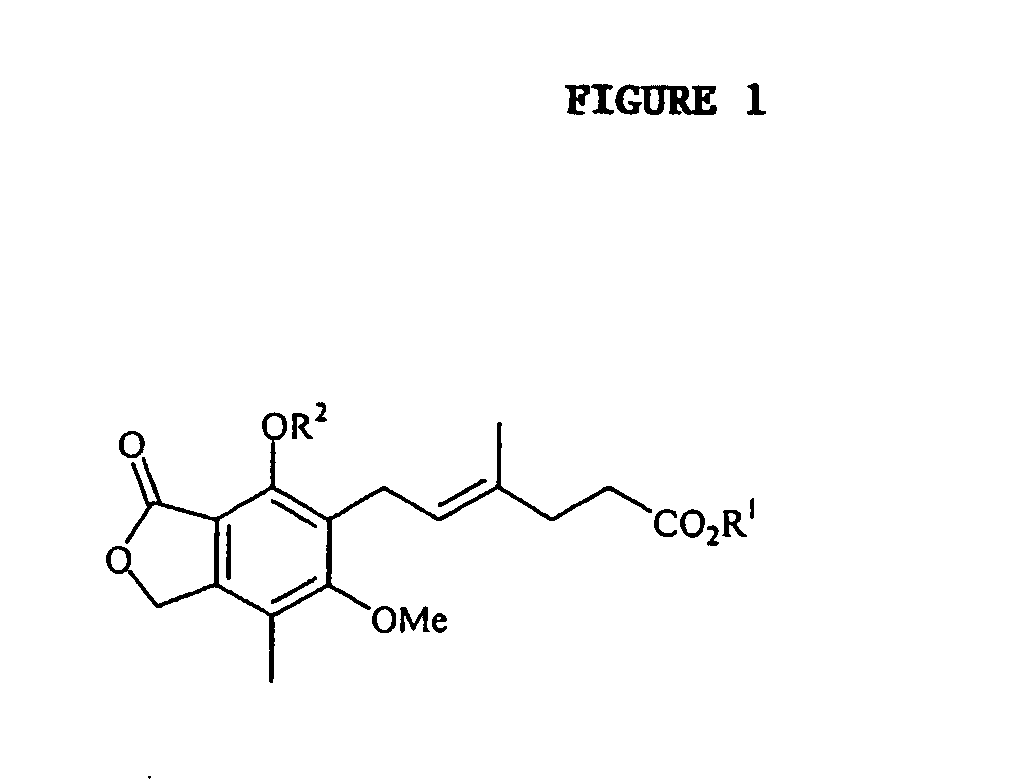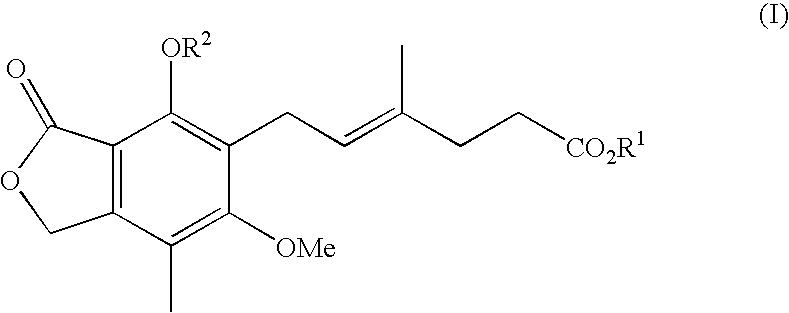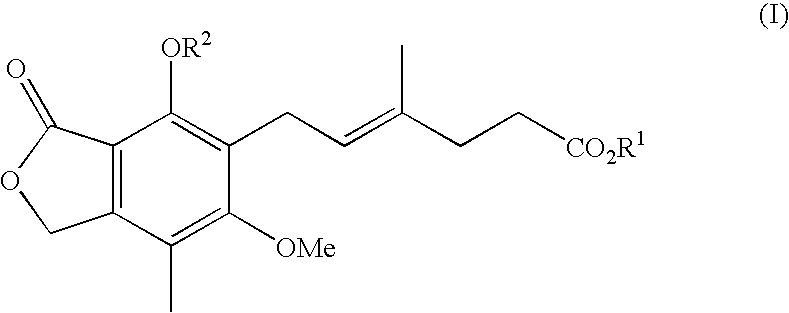Method of mycophenolate mofetil preparation
a technology of mycophenolate and mofetil, which is applied in the field of mycophenolate mofetil preparation, can solve the problems of inability to use the method in the industry, unjustified amount of impurities and dicyclohexylurea, and product colour, and achieves easy isolation from high-boiling solvents, reduced reaction time, and low solubility of mycophenolate mofetil
- Summary
- Abstract
- Description
- Claims
- Application Information
AI Technical Summary
Benefits of technology
Problems solved by technology
Method used
Image
Examples
example 1
[0012] Mycophenolate mofetil; use of dibutyl ether as solvent
[0013] 10 g mycophenolic acid were put in a reaction flask with a reflux cooler together with 20 ml dibutyl ether. Stirring vigorously the mixture was warmed up to the temperature of 50 to 60° C. and then 4 ml 2-morpholinoethanol were dropped in. The reaction mixture was warmed up to boiling under azeotropic separation of water. After 48 hours the mixture was cooled up to the laboratory temperature and diluted with 20 ml dichloromethane. The solution was extracted twice with 10 ml 0.5 M aqueous K2CO3 and once with 10 ml of water. Then dichloromethane was distilled off under vacuum and the suspension was cooled up to 10 to 15° C. Crystallized mycophenolate mofetil was removed by suction and recrystallized from ethyl acetate. After the removal by suction and drying the crystals 11 g (78%) mycophenolate mofetil was obtained with purity>99.0% (HPLC).
example 2
[0014] Mycophenolate mofetil; use of dipentyl ether as solvent
[0015] 10 g mycophenolic acid were put in a reaction flask with a reflux cooler together with 20 ml dipentyl ether. Stirring vigorously the mixture was warmed up to the temperature of 50 to 60° C. and then 4 ml 2-morpholinoethanol were dropped in. The reaction mixture was warmed up to boiling under azeotropic separation of water. After 6 hours the mixture was cooled up to the laboratory temperature and diluted with 20 ml dichloromethane. The solution was extracted twice with 10 ml 0.5 M aqueous K2CO3 and once with 10 ml of water. Then dichloromethane was distilled off under vacuum and the suspension was cooled up to 10 to 15° C. Crystallized mycophenolate mofetil was removed by suction and recrystallized from ethyl acetate. After the removal by suction and drying the crystals 10 g (71%) mycophenolate mofetil was obtained with purity>99.0% (HPLC).
example 3
[0016] Mycophenolate mofetil; use excess of 2-morfpholinoethanol
[0017] 10 g mycophenolic acid was put in a reaction flask with a reflux cooler together with 20 ml dibutyl ether. Stirring vigorously the mixture was warmed up to the temperature of 50 to 60° C. and then 4,8 ml 2-morpholinoethanol was added in. The reaction mixture was warmed up to boiling under azeotropic separation of water. After 15 hours the mixture was cooled up to the laboratory temperature and diluted with 25 ml dichloromethane. The solution was extracted twice with 10 ml of 1% aqueous ammonia and once with 10 ml of water. Then dichloromethane was distilled off under vacuum and the suspension was cooled up to 10 to 15° C. Crystallized mycophenolate mofetil was removed by suction and recrystallized from ethyl acetate. After the removal by suction and drying the crystals 11,1 g (82%) mycophenolate mofetil was obtained with purity>99.0% (HPLC).
PUM
 Login to View More
Login to View More Abstract
Description
Claims
Application Information
 Login to View More
Login to View More - R&D
- Intellectual Property
- Life Sciences
- Materials
- Tech Scout
- Unparalleled Data Quality
- Higher Quality Content
- 60% Fewer Hallucinations
Browse by: Latest US Patents, China's latest patents, Technical Efficacy Thesaurus, Application Domain, Technology Topic, Popular Technical Reports.
© 2025 PatSnap. All rights reserved.Legal|Privacy policy|Modern Slavery Act Transparency Statement|Sitemap|About US| Contact US: help@patsnap.com



